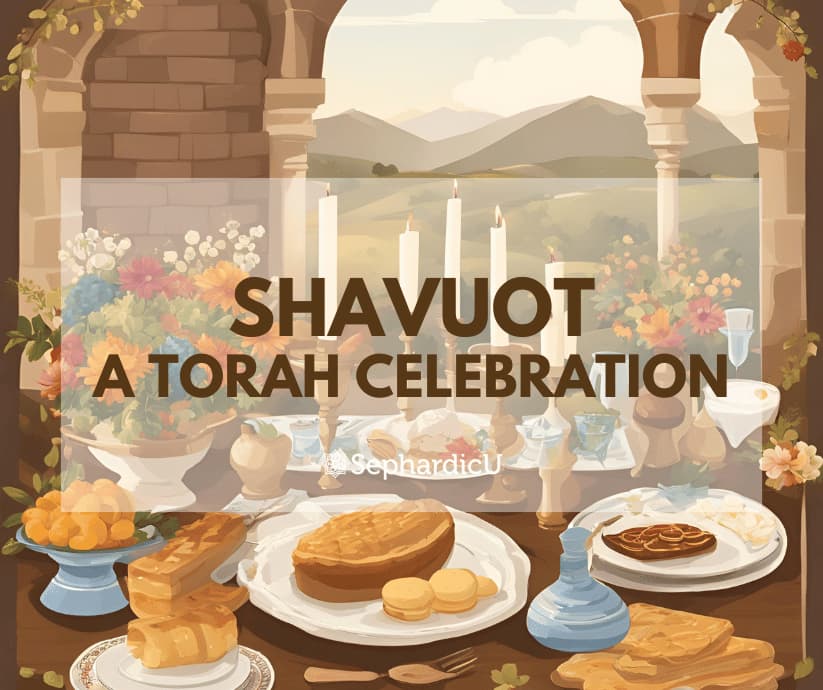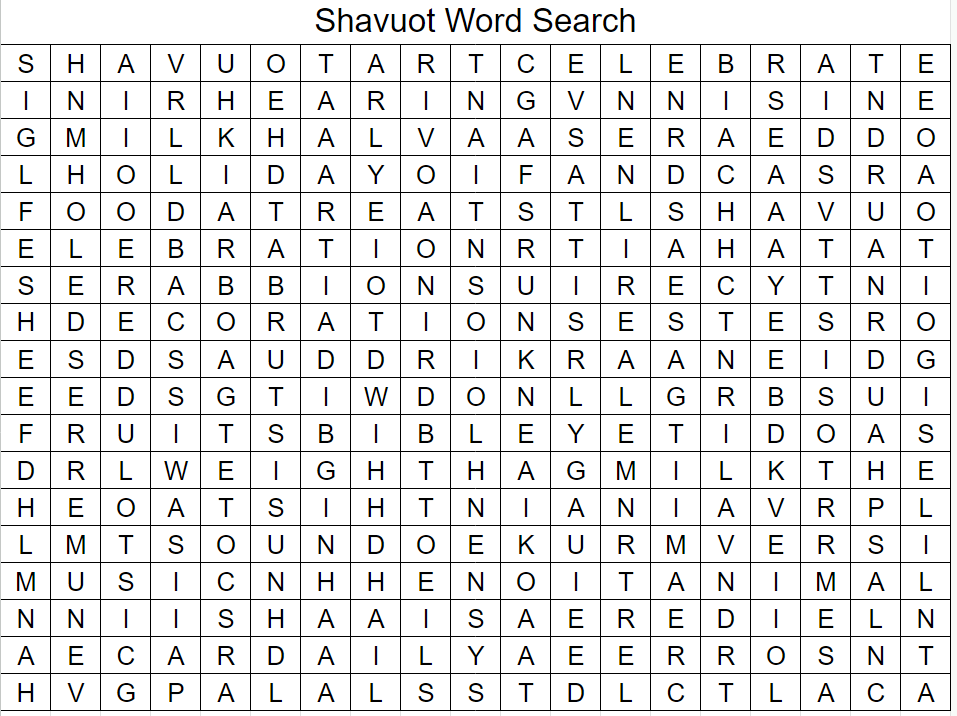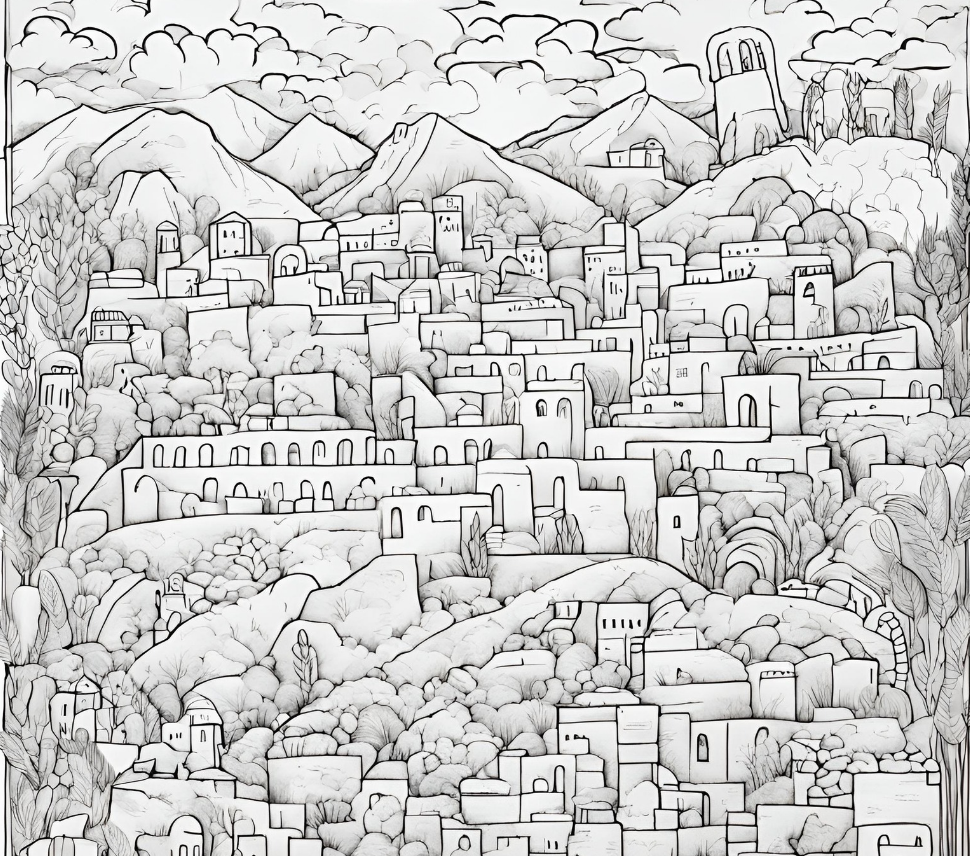commemorates the revelation of the Torah on Mt. Sinai

Shavuot is a holiday steeped in Jewish history and culture. In Sephardic tradition, it is known as Hag Shavuot. It honors two noteworthy occasions:
The Torah Giving: Shavuot commemorates the day that the Jewish people received the Torah at Mount Sinai. Jewish tradition states that the Israelites traveled to Mount Sinai after being freed from Egyptian slavery, where God gave Moses and the Israelites as a whole the Torah. The cornerstone of Jewish faith and identity was laid by this historic event, which created the covenant between God and the Jewish people.
The Harvest Festival: Shavuot is not only a religious holiday but also an agricultural celebration of the wheat harvest in ancient Israel. As a token of appreciation to God, farmers would deliver the first fruits of their harvest to the Temple in Jerusalem. This Shavuot feature emphasizes the themes of abundance and rejuvenation as well as the relationship between the Jewish people and the country of Israel.
For Sephardic Jews, Shavuot is a season of spiritual rebirth, communal joy, and cultural continuity that has modern significance:
Spiritual Enrichment: By study, meditation, and contemplation, Sephardic Jews can strengthen their ties to Jewish tradition and legacy during Shavuot.
Cultural Heritage: Shavuot customs and traditions weave a rich tapestry of Sephardic culture and heritage, giving Sephardic communities around the world a sense of identification and belonging.
Strengthening of Families and Communities: Shavuot is a time when families and communities gather to share meals, tales, and customs that have been passed down through the years. It fortifies the ties of solidarity and kinship that characterize Sephardic communal life.
To sum up, Shavuot is a beloved holiday in Sephardic culture that combines traditional customs with modern manifestations of faith and identity. It is evidence of the Sephardic culture’s continuing vitality as well as the ageless principles of Torah, community, and compassion.
Shavuot, known as the Festival of Weeks, is celebrated with various customs and traditions that hold deep significance for Jewish communities worldwide. Explore some of the unique customs associated with Shavuot.
Tikkun Leil Shavuot: Sephardic communities observe the tradition of Tikkun Leil Shavuot, where congregants gather for all-night Torah study sessions. This tradition symbolizes the commitment to lifelong learning and the importance of Torah study in Jewish life.
Mikveh Ritual: It is customary for Sephardic Jews to immerse in a mikveh (ritual bath) on the eve of Shavuot as a symbol of spiritual purification and preparation for receiving the Torah. Some may also choose to immerse on the morning of Shavuot itself.
Special Torah Readings: Sephardic congregations may include special Torah readings and prayers during Shavuot services. For example, the reading of the Ketubah le Shabuot, a poetic composition resembling a marriage contract between God and Israel, is a common practice.
Unique Dietary Customs: Shavuot is often celebrated with festive meals featuring traditional foods. While Ashkenazi Jews typically consume dairy dishes, Sephardic Jews may have different culinary customs. Most families serve meat dishes or incorporate symbolic foods such as barley, wheat, dates, figs, olives, grapes, and pomegranates into their meals.
Water Festival: In some Sephardic communities, Shavuot is also known as a water festival. It is customary to splash water on each other as a reminder of the Torah flowing like water and the story of Moses being drawn from the water as a baby.
These customs and traditions, observed by Sephardic Jews and others, contribute to the richness and depth of the Shavuot holiday, serving as reminders of the enduring covenant between God and the Jewish people and the importance of Torah study and spiritual renewal.
Content adapted from a speech by Deanna (Amar) Pool at Kehilath Israel Synagogue, Overland Park, Kansas, during overnight Shavuot in May 2002.
This table highlights the primary differences in customs between Ashkenazi and Sephardic communities during the holiday of Shavuot.
| Custom | Sephardic | Ashkenazic |
|---|---|---|
| Counting the Omer | Scrupulous observance, often with a Sefirat Haomer plaque to track progress. | Similar observance, counting the Omer is significant in both traditions. |
| Mikveh | Common practice to visit the mikveh on erev Shavuot or the morning of Shavuot. | Not commonly associated with Shavuot in Ashkenazic tradition. |
| All-night Torah Study (Tikkun Leil Shavuot) | Prominent practice, symbolizing commitment to Torah study. | Also observed, reflecting dedication to Torah learning. |
| Reading of Ketubah le Shabuot | Reading a love song patterned after Shir Hashirim, symbolizing the covenant between God and Israel. | Not a standard practice in Ashkenazic tradition. |
| Recitation of Azkarat Neshamot | Memorial service commemorating deceased loved ones. | Observance of Yizkor, commemorating deceased loved ones. |
| Recitation of Azharot | Chanting a rhymed listing of the 613 commandments, composed by Shlomo Ibn Gabirol. | Recitation of the Akdamut, a liturgical poem praising God and the Torah. |
| Culinary Customs | Avoidance of dairy products, preference for meat and wine at festive meals. Serving foods representing the seven species native to Israel. | Tradition of eating dairy foods, such as cheesecake and blintzes. May also serve traditional Ashkenazic dishes. |
| Baking Special Bread | Baking bread shaped like Mount Sinai or doves, symbolizing aspects of the Shavuot story. | Not a standard practice, but may include baking traditional breads or challah for the holiday. |

Shavuot bread in the shape of a dove for the holiday.

A Moroccan cuisine staple. We serve this on Shavuot holidays.

A staple in every Moroccan home

A Shavuot staple. It's a cereal grain that can grow even in bad soil and poor weather conditions.

A delicious recipe highlighting the wheat harvest of Shavuot.

A Moroccan cuisine staple. We serve this on Shavuot holidays.

Download our Shavuot word search and print it out for the kids. A great activity.

Practice your coloring skills with our Shavuot in Israel coloring page.

Can you deliver the wheat to Jerusalem before Shavuot begins?
Visually interact and learn about our nearly 6000 year history.
An interactive tour through our rich heritage spanning from 900 B.C.E.
Learn about our numbers, languages and population.
The greatest minds, philosophers and authors of their time.
Everything you wanted to know about Sephardic customs.
Learn our traditions for brit to marriage and bereavement.
Food is the universal thing that has the power to bring people together.
Listen to the rich repertory of Sephardi music and prayers.
Connect to our calendar for the latest events and happenings.
Read real-time updates as the relates to the Sephardic world.
We welcome you to join us virtually for Shacharit and Arvit.
Make new friends while expanding your mind. Quarterly. Join now.
View the full list of every Jewish holiday and observance.
Browse through our recommended reading list of over 100 books.
Download our guides to help you plan for the Holidays.
We welcome all in need of prayer, healing or Kaddish.

Login to your account
Get notified about new articles